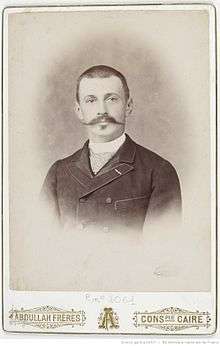Jacques de Morgan
Jean-Jacques de Morgan (3 June 1857, Huisseau-sur-Cosson, Loir-et-Cher – 14 June 1924) [1] was a French mining engineer,[2] geologist, and archaeologist. He was the director of antiquities in Egypt during the 19th century,[3] and excavated in Memphis and Dashur, providing many drawings of many Egyptian pyramids. He also worked at Stonehenge, and Persepolis, and many other sites.

He also went to Russian Armenia, as manager of a copper mine at Akhtala. "The Caucasus is of special interest in the study of the origins of metals; it is the easternmost point from which prehistoric remains are known; older than Europe and Greece, it still retains the traces of those civilizations that were the cradle of our own."
In 1887-89 he unearthed 576 graves around Alaverdi and Akhatala, near the Tiflis-Alexandropol railway line.[4]
Background
His father Eugène, also called "Baron" de Morgan, was an engineer in mineral findings. His interests were in entomology and prehistory. He named his two sons, Henry and Jacques. His sons later got into fieldwork, excavating the Campigny faults near Rouen with him, which had lent its name to the first phase of the European Neolithic. With his father Jacques became acquainted with Gabriel de Mortillet, who was connected with the museum of national antiquities in Saint-Germain during investigations of Merovingian cemeteries, and who showed him how to catalogue excavated objects. De Morgan's goal was to be a professional geologist like his father, and his personal lifestyle had given him a way to travel and study since his early youth. In 1879 he started to publish the results of his research, illustrated with drawings that were notable for their finesse and documentary precision.
Malaya
As a young man, de Morgan travelled to Perak, then a new British protectorate in Malaya. In 1884, where he was commissioned by Hugh Low, the Resident of Perak, to produce the first geological and mining map of the district of Kinta in exchange for a tin concession at Kliang Lallang near Gopeng. De Morgan studied the tin mines around Lahat, Papan, Pusing and Gopeng. A photogravure of the map, which also showed the topography and drainage system of the Kinta Valley, was enclosed in the Perak annual report of 1884.[5]
While in Kinta, de Morgan was guided by a Mandailing prospector named Kulop Riau, using Orang Asli guides and porters. De Morgan stayed with the Orang Asli and made ethnological observations and drawings in his travel journal.[6] De Morgan also met Raja Bilah, the headman of the Mandailing in Papan and the doyen of the Perak Mandailing. De Morgan observed Chinese, Mandailing and European mines in Papan, and remarked that the most important mine belonged to Raja Bilah.[7]
Upon his return to France, he formed a tin-mining company, but appears to have lost out on his financial interest when this was merged with the Société des Mines de'Etain de Pérak in 1886 to form the Société des Etains de Kinta, better known as SEK, which became the longest-running mine in Malaysia.[8]
Travels
De Morgan travelled to Susiana as he attempted to retrace the routes of the Assyrian campaigns in Elam. He arrived in Susa, former capital of Elam, which had been explored six years previously by an expedition led by Marcel Dieulafoy. As he explored the ruins outside the small village of Shush, his curiosity was aroused by the high mound known as "the Citadel", at the foot of which he recovered some flints and old potsherds.
These finds led him to reopen excavations at the site. In Tehran he confided his plans to the French minister, René de Balloy, who was eager to obtain a monopoly for France of archaeological research in Persia. It took time, however, before these efforts, under de Morgan's guidance, were successful. In the meantime he published his Mission scientifique en Perse, with four volumes of geological studies; two volumes of archaeological studies on tombs and other monuments that were still seen; one volume dedicated to Kurdish dialects and the languages of northern Persia; one volume of Mandaean texts; and two volumes of geographical studies.
The excavations at Susa were headed by Jacques de Morgan in 1897 and carried on by others until the outbreak of World War I. Among their many discoveries are eight perforated plaques, three of them whole or nearly whole, and the rest fragmentary.[9]
The most important find, however, was the famous Victory Stele of Naram-Sin, brought to Susa as war booty by the Elamite king Shutruk-Nahhunte.
References
- The Experience of Ancient Egypt - Page 137 by Ann Rosalie David
- Satellite Images and Near Eastern Landscapes, by Nicholas Kouchoukos p.80
- Who Was Who in Egyptology ... - Page 82 by Warren Royal Dawson
- A History of Armenia by Vahan M. Kurkjian, p.8
- Khoo Salma Nasution and Abdur-Razzaq Lubis, Kinta Valley: Pioneering Malaysia’s Modern Development, Ipoh: Perak Academy, 2005, p. 21, 89.
- Khoo Salma Nasution and Abdur-Razzaq Lubis, Kinta Valley: Pioneering Malaysia’s Modern Development, Ipoh: Perak Academy, 2005, p. 354.
- Abdur-Razzaq Lubis and Khoo Salma Nasution, Raja Bilah and the Mandailings in Perak: 1875-1911, Kuala Lumpur: Malaysian Branch of the Royal Asiatic Society, 2003, p. 89.
- Khoo Salma Nasution and Abdur-Razzaq Lubis, Kinta Valley: Pioneering Malaysia’s Modern Development, Ipoh: Perak Academy, 2005, p. 89-90.
- Dating the Early Dynastic Votive Plaques from Susa, by Suzanne M. Pelzel P. 1
Bibliography
- Idem, "Exploration dans la presqu'île malaise. Moeurs, coutumes et langages des Negritos Sakayes et Seumangs,"
- L'humanité préhistorique: esquisse de préhistoire générale
- “Note sur les gîtes de naphte de Kend-e Chirin,” Annales des mines, February 1892, pp. 1–16
- Morgan, Jacques de (1895–1904), Mission scientifique en Perse, 3 parts II–IV, Etudes géologiques. Paléontologie, Part II. Echinides fossiles by Gustave Cotteau and Victor Gauthier; Part III. Echinides fossiles (supplément) by Victor Gauthier; Part IV. Mollusques fossiles by H. Douvillé, Paris: E. Leroux